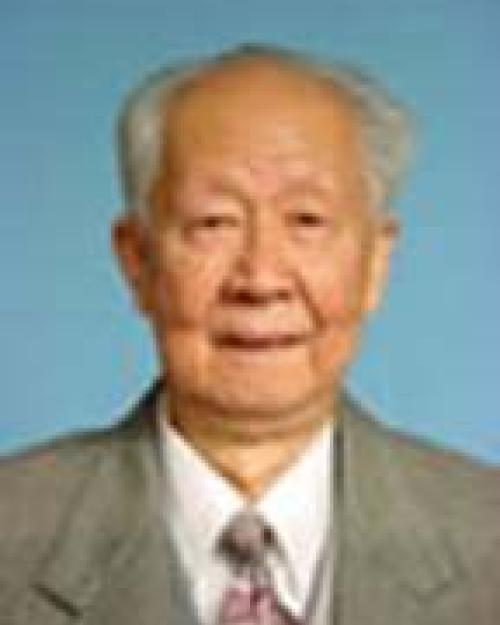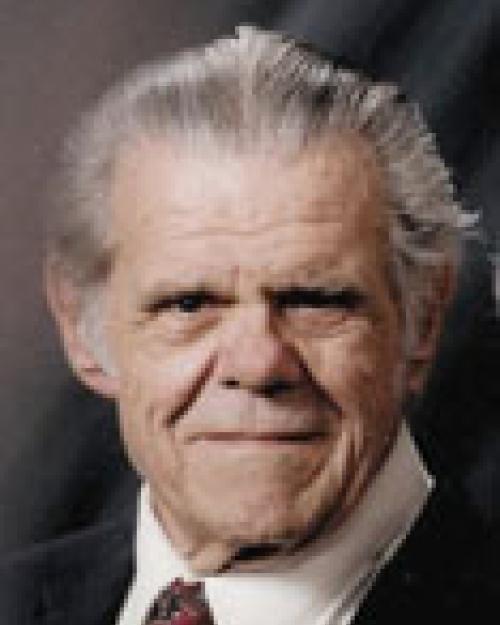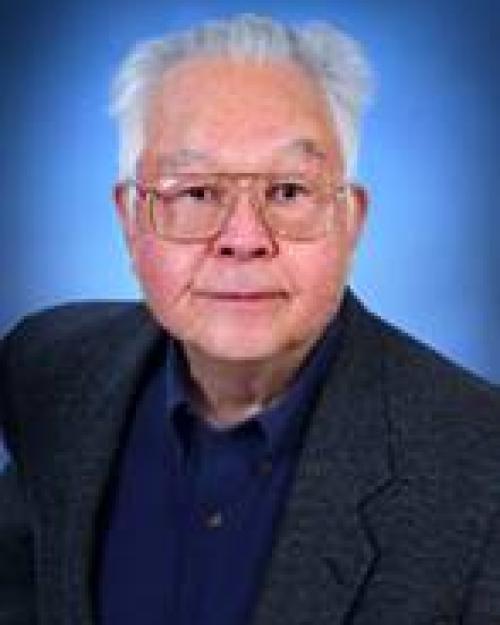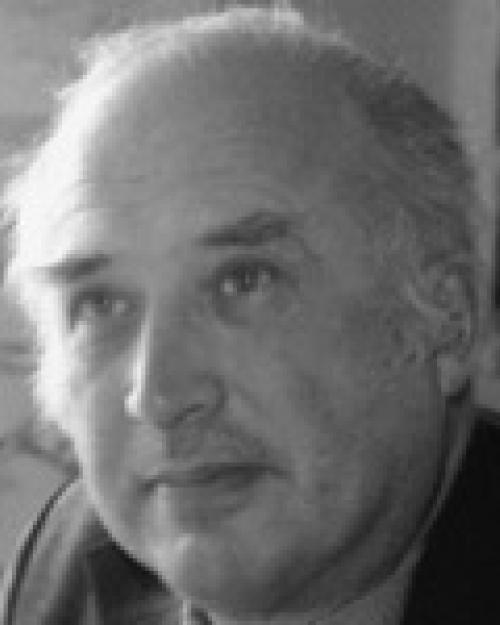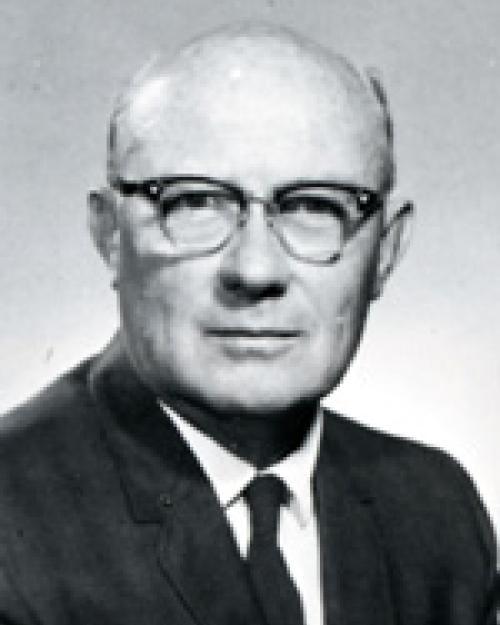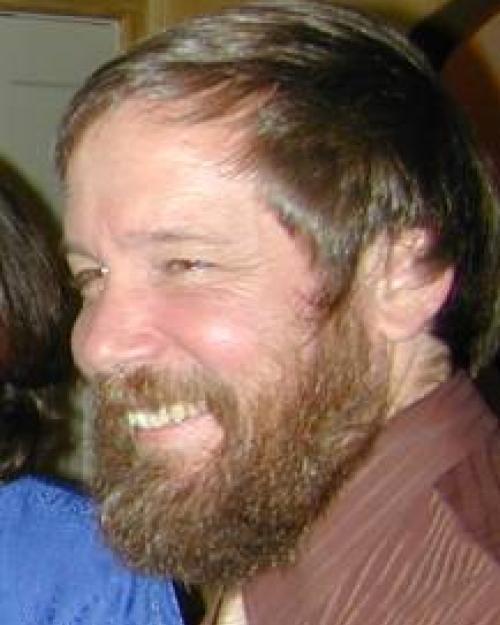-

Zhiwen Yin
-Prof. Zhiwen Yin was Academician of the Chinese Academy of Sciences, former Deputy Director of the Shanghai Institute of Ceramics, Director of the Academic Committee, and a former member of the Ferroelectrics Committee, IEEE-UFFC. Prof. Zhiwen Yin passed away on July 18, 2006 at Shanghai Huadong Hospital, China, at the age of 88. Prof. Yin graduated from the Department of Mining and Metallurgy, Yunnan University in 1942 and received M.S. degrees from the Department of Metallurgy, University of Missouri, Rolla and the Department of Ceramic Engineering, University of Illinois, U.S.A. in 1948 and 1950 respectively. He was elected to be a member of the Chinese Academy of Sciences in 1993. As a materials scientist and Professor of Shanghai Institute of Ceramics, Chinese Academy of Sciences, Prof. Yin devoted his lifetime to the research on functional ceramics, ferroelectrics, and scintillation crystals. He was one of the pioneers in the research and development of the lead zirconium titanate (PZT) piezoelectric ceramics in China and made important contributions to the research and applications of China’s functional ceramic materials. He conducted research work on the phase transition and microstructure changes in relaxor ferroelectrics, PLZT transparent ceramics, and the observation of the nanometer size polar micro-regions in PLZT. He was engaged in the scintillation crystals research since the early 1980’s. After recognizing the radiation damage in the bismuth germanate (BGO) crystal was the result of radiation-induced color centers due to oxygen vacancies in the crystal, he successfully developed a new type of Eu-doped BGO scintillation crystal with high radiation hardness. The scintillation crystal research group led by him provided more than 10,000 pieces of large size BGO crystals for the construction of the electromagnetic calorimeter in the European Nuclear Research Center (CERN). His work on the halide scintillation crystals such as BaF2, CaF2, PbF2, Csl(TI), etc., was also of seminal significance and well recognized worldwide. Prof. Yin was known for his cheerfulness and his contagious laughter. He is missed by the international ferroelectrics community.

John H. Sherman, Jr.
-John H. Sherman, Jr. – Quartz Crystal Industry Personality 1918 – 2006 John H. Sherman, Jr., a Lynchburg resident since January, 1959, died on April 7, 2006. His death was a consequence of an untreatable liver tumor. He was born at Lewis Gale Hospital on Aug 12, 1918, the son of John H Sherman of Ash Grove, VA and Mary Mosby Stephens Sherman of Christiansburg. Some of his many contributions to quartz crystal technology are documented in the Proceedings of the Frequency Control Symposium. In 1955 (vacuum tube days) he created the concept of “trim sensitivity,” while working as a components engineer. He then became a Quartz Crystal Engineer and transferred to the General Electric Mobile Radio Division in Lynchburg, Virginia. He worked on crystal resonators, monolithic filters, and surface wave filters. He was dedicated to the application of scientific study to the manufacturing process, to the point of using vacation time and paying his own way to crystal conferences before management saw the value in it. From 1969-1979 he was Chairman of EIA Working Group P5.4, the “EIA Technical Working Group for the Frequency Control Industry.” In 1980 he wrote the first interactive computer program for the design of AT resonators. He continued as a consultant after retiring from GE. His early education was primarily in the public schools of Illinois. He prepared himself to be a symphony orchestra musician studying French horn with Max Pottag, Alberto Stagliano, and Edward Murphy. He studied conducting with Clarke Kessler and Vladimir Bakaleinikoff.. At the advice of Bakaleinikoff he completed a regular college degree with majors in Mathematics and Chemistry at the University of Tampa. He was auditioning with the Buffalo Philharmonic when the Army called him and he was appointed first horn of the band at Byrd Field. The Army then reassigned him into the Army specialized training program (ASTP) at Lehigh University. Everyone who completed the course of study in this program was assigned into the Manhattan Engineering District. The ASTP was discontinued before he completed his course and he was assigned to the 3186th Signal Service Battalion in which he saw service in both the European and Far Eastern theaters. At the end of the war he returned to Lehigh University and completed a Masters degree in Electrical Engineering. After 3 years of teaching he took employment at General Electric Co. in Syracuse NY and spent 29 yrs with GE, 27 of them working with quartz crystal resonators. In Syracuse he participated in the revitalization of the Syracuse Symphony. When transferred to Lynchburg he was instrumental in the founding of the orchestra which has developed into the Lynchburg Symphony and has played under all six of the music directors of the symphony. He was on the board of Community Concerts for 33 years, President for 21 of them. He served on the board of the Academy of Music before it combined with the Fine Arts Center. Among his many accomplishments, he was selected Senior Elfun of the Year, awarded the national Piezoelectric Devices Man of the Year, and shot a hole in one on the 5th hole at Oakwood Country Club. He is survived by his wife, Marie, two daughters, Mary Sherman and Ida Cole, two grandchildren, Dr. Janis Taube (and husband Dr. Alexander Hillel) and H. Joseph Ramagli, III (and fiancée Emily Hornback), and by his sister, Frances Sherman Bailey, of Ridgewood, NJ. Extended family include Susan and Shawn Underwood, Michael Silvester, Matthew Silvester, Dan and Kelly Silvester, Christopher Silvester, Howard J. Ramagli, Jr., and Arthur Caisse. Memorial gifts may be sent to First Unitarian Church, 818 Court Street, Lynchburg, VA 24504 or Academy of Fine Arts, 600 Main Street, Lynchburg, VA 24504.

Wallace H.E. Samuelson
-Wallace H.E. Samuelson – Quartz Crystal Industry Leader and Innovator 1919 – 2005 Wallace H. E. Samuelson, 86, died Jan. 24, 2005, in Birmingham, Ala. Mr. Samuelson grew up in New York City. He was a graduate of Antioch College and Harvard University with a master’s degree in communication engineering. He married Lois Samuelson in 1939. He briefly taught physics at Antioch College, but his main occupation was in the quartz crystal electronics business initially in Rochester, N.Y., and Weehawken, N.J., and then later in Carlisle, where he moved to in about 1946. After their children left for college he and Lois moved to Harrisburg where they remained until 1997. Wally owned and operated Piezo Crystal Co. for many years with friend and partner Herman Shall, designing and manufacturing components for radio communication devices for the Armed Forces, private industry, and space exploration. After selling the plant, he continued as an engineering management consultant until the early 1990s. After Herman’s untimely death in 1970, he ably acted as surrogate father and grandfather for the Shall family: Tillie (widow) and children Maxine, David, Donald and Michael. He and Lois moved to Birmingham, Ala., in 1997 to be near their son. Lois died in 1997. He again fell in love and married Peggy Benjamin in 1999. Wally was a very kind, friendly, loving, generous person. He was analytical, inquisitive, academic, scholarly and a patient teacher for Paul and Basja during their school years, and to employees and friends. He was known for his love of travel, good food and wine. He loved, and was loved in return, by all who knew him. Bill Hanson (Hanson Technologies, Inc.) has provided the following personal remembrances of Wally: “Wally and my family became very close. Wally was the best man at my wedding and we had lunch almost every week for 17 years. His generosity and grace was ever-present and I was fortunate to have him as a mentor at Piezo Crystal Company from 1980 to 1997. Wally’s expertise in production and engineering of quartz resonators was superb with experience spanning over 50 years. One fascinating story about Wally, which isn’t well known, is that he made blast sensors for the Manhattan project during WWII. I believe he did this in graduate school at Harvard working for Professor Charles Palache. He was assigned the task of cutting tourmaline crystals taken from German museums and making stacked blasting sensors. Wally said he cut many beautiful crystals, with many shattering even though they looked flawless. He was told the blast sensors worked perfectly measuring the explosive force of the atomic bomb. Wally was an incredible teacher and mentor who knew everyone’s name and was always a gentleman. Wally helped advance the SC cut x-raying and cutting operation at Piezo from a single blank cutting operation to slurry saw in the early 80’s. This process was used to produce over one million SC’s sold from 1984 to 2001. This same process was used in 1997 to help develop the cutting of SC’s on the wire saw, successfully eliminating angle correction. Wally’s incredible energy and intellect will be missed greatly by myself and the crystal industry.”

Gen Shirane
-Gen Shirane was arguably the world’s foremost expert in the use of triple-axis neutron spectroscopy, which he used to study a broad class of problems in condensed matter physics covering ferroelectricity, magnetism, and high-TCsuperconductivity. One of a truly select few individuals, Gen maintained an intense level of activity far exceeding that of most scientists half his age; indeed, he was in the midst of collaborations with junior scientists on several papers and experiments when he died suddenly from a stroke at the age of 80 on January 16th, 2005. Gen began his career by studying the phase transitions in ferroelectric materials and later moved on to investigate the structure and dynamics of countless magnetic and superconducting materials. His return to the field of ferroelectrics near the end of his life marked a fitting end to a spectacular career that was filled with remarkable discoveries and accomplishments spanning more than half a century. Gen was born in Ashiya, Japan, just west of Kobe in 1924, and he received his Doctor of Science in Physics from the University of Tokyo in 1954. His thesis dealt with ferroelectrics, and his first publication appeared in 1947. Gen had already established an international reputation when he came to the U.S. in 1952 to continue his studies of ferroelectrics with Pepinsky at Penn State University. Gen performed his first neutron diffraction study in 1955 on PbTiO3. Recognizing the power of neutron scattering, Gen moved to Westinghouse Research Laboratories in 1957 to work at their new research reactor. When support for basic research waned at Westinghouse Gen moved on to Brookhaven National Laboratory in 1963. That was his last move. During this period he co-authored a book entitled “Ferroelectric Crystals” with Franco Jona in 1962, which is now considered a classic and is still used extensively by researchers worldwide. When the High Flux Beam Reactor (HFBR) at Brookhaven commenced operations in 1965 Gen turned to neutron inelastic scattering. He studied spin-wave dispersions and critical phenomena in ferromagnets, soft phonon modes and structural phase transitions in ferroelectric perovskites, spin fluctuations in low-dimensional antiferromagnets, electron-phonon coupling in superconducting Nb3Sn, spin waves in chromium, and eventually high-TC superconductors. With the demise of the HFBR in 1999, Gen chose to return to his first love, ferroelectrics, managing an active program of x-ray diffraction experiments at the National Synchrotron Light Source, located just across the street from the HFBR, as well as neutron scattering studies, performed mostly at the NIST Center for Neutron Research. His last area of research, though certainly not his least, was on the structural and dynamical properties of the relaxor ferroelectric systems PMN-xPT and PZN-xPT. If citations are a measure of a scientist’s professional stature, then Gen Shirane was a giant. His unceasing drive and enthusiasm led to the phenomenal output of more than 750 papers, which have garnered nearly 40,000 citations, and an astonishing “h-index” of 103, one of the highest of any physicist in any field. In addition to his classic text “Ferroelectric Crystals,” Gen also coauthored a book on triple-axis neutron spectroscopy in 2002. The profound respect accorded Gen’s research by the physics community is evidenced by his ranking #27 in the list of the “1000 Most Cited Physicists, 1981-1997.” Gen also ranks among the top 300 physicists in the “1,000 Contemporary Scientists Most Cited in 1965-1978.” Yet most impressive of all is the fact that Gen is one of only eight physicists to appear in both of these lists – striking testament to Gen’s sustained scientific excellence over four decades. Gen’s earlier scientific achievements were recognized in 1973 when he was awarded both the Oliver E. Buckley Prize, the most prestigious award in condensed matter science given by the American Physical Society, and the Warren Award, the most prestigious prize bestowed by the American Crystallographic Association. Gen later received his highest honor when he was elected to the U.S. National Academy of Sciences in 1989. Gen was also a recipient of a von Humboldt award (Germany), the DOE Award for Outstanding Scientific Accomplishment in Solid State Physics in 1989, and the Award for Outstanding Accomplishment from the Japanese Society for Neutron Science in 2003. Gen was a fellow of both the American Academy of Arts and Sciences and the American Physical Society. His lofty accolades notwithstanding, Gen’s most lasting accomplishment lies with the generations of scientists that he trained and mentored, many of whom are now international scientific leaders in their own right. Gen enjoyed working with young scientists and was famous for pushing these young researchers extremely hard. Of course, Gen was highly competitive in everything he did, whether it was performing a triple-axis experiment or playing tennis or poker. He would often ask postdoctoral candidates whether or not they played poker during their job interviews, and his eyes would twinkle if they said no, but that they were willing to learn. He kept a copy of “The Education of a Poker Player” by Herbert O. Yardley on hand for just such occasions. Gen is survived by his wife Sakae, well known for her kindness and hospitality while entertaining many Brookhaven visitors at Gen and Sakae’s home in Bellport, NY, and for her love of music and ability to play the piano beautifully. Gen is also survived by his two sons, Haruo and Tatsuo, their wives, and three grandchildren. He will be remembered by his family, friends, and everyone he worked with, each through different memories that define Gen as a man of integrity, a good friend, and one of the greatest scientists in the field of physics and neutron scattering. His passing marks the end of an era. (Contributor: Peter M. Gehring)

Robert Smythe
-Robert C. Smythe – industry leader, researcher, IEEE Fellow and Cady Award winner 1929 – 2004 The Quartz Crystal Industry lost one of its leaders and mentors with the death of Robert Chastain Smythe, on April 13, 2004. He was actively involved in both Industry and Academia for over 40 years. In 1991 he was presented the W. G. Cady Award, “For contributions to the development of single and dual mode quartz resonators for filter applications.” He was made a Fellow of the IEEE (UFFC), in 1997. Bob Smythe was born on August 28, 1929, in Orlando, Florida, where he lived for almost his entire life. He received a BA degree in 1952 and a BSEE degree in 1953, both from Rice University. After working for Hazeltine Corporation for a short time, he joined the U.S. Army, where he served for two years, as an Instructor, fire control radar. Upon leaving the Army in 1956, he resumed his education at the University of Florida, where he received an MSEE degree in 1957. In 1956 he joined Systems, Inc., the predecessor of Piezo Technology Inc., (PTI). He was one of the founders of PTI, in Orlando, Florida, in 1965. Bob Smythe’s long career at PTI was characterized by his prolific and significant contributions to the advancement of the theoretical and practical aspects of frequency control devices. He was the author of over 60 papers on resonators and resonator theory. He was also co-author of a textbook on piezoelectric devices and filters and held several patents. He had many other ideas worthy of patent recognition and was unstinting in his willingness to share his knowledge with, and offer advice to anyone working in the field of frequency control. Colleagues in the industry considered him a generous, accessible and rare repository of wisdom and knowledge. Bob’s generosity was reflected in his continuing involvement at Rice University, where he was an active alumnus and for which institution he had a great affection. He also contributed his time to serve the frequency control profession through his many years of service on the program committee of the IEEE Frequency Control Symposium, and on IEEE standards committees. His first PTI assignment was to establish the design of VHF coupled mode crystal filters – devices that are used at the front end of a radio receiver to protect against intermodulation distortion and cross talk. Several of his designs from that time are still in production at PTI. During the hectic early years of growing his young company, he showed his commitment to gaining understanding in his chosen field by completing most of the course work for a doctorate in 1964-1966 at the University of Florida. He directed a team that improved the producibility of coupled mode quartz resonators to the level where they became practical and efficient building blocks in the realization of complex filters. He was involved in all activities, from writing software for the design of coupled mode resonators, to designing production equipment necessary to produce the parts in high volume. Using the resulting technology, the production of coupled mode resonators increased to over 30,000 units per day. Particularly significant advances were made in the computerized test and measurement of resonators and filters using network analyzers. Later Bob moved on to study the fundamental properties of crystal resonators. He had a particular interest in the measurement, characterization and causes of intermodulation distortion, drive level sensitivity, phase noise and acceleration-sensitivity. He worked tirelessly to expand the range and capabilities of the company’s products, from highly stable doubly rotated quartz crystal standards to high frequency fundamental mode resonators and filters. Most recently, until his unfortunate illness, he was working on the measurement and characterization of the fundamental properties of the LGx family of piezoelectric materials. Bob will be missed by his colleagues at PTI and his friends across the world, particularly those from our industry.

Lev Aleksandrovich Shuvalov
-It is with great sadness that the international ferroelectrics community bids farewell to Professor Lev Shuvalov who died in Moscow in December 2004 in his eighty-first year. Lev Alexandrovitch, as he was affectionately known to his Russian and non-Russian friends, was one of the world’s leading scientists in ferroelectrics and related materials. Over a long and productive life, he was a pioneer in many of the most important developments in the field of ferroelectricity and phase transitions. Lev Shuvalov’s international reputation was first established in the 1950s and 1960s for his classical work on the crystal symmetry and classification of ferroelectrics. Some of us will remember the brilliant paper on the topic that he delivered at the 2nd International Meeting on Ferroelectricity held in Kyoto, Japan in 1969. This basic approach allowed him in the 1970s and 1980s to make important fundamental studies of the changes in symmetry that occur at phase transitions in ferroelectric, ferroelastic and ferromagnetic materials. This pioneering work in turn led to his fundamental studies of domains in both classical ferroelectrics and ferroelastics. During his long and successful career at the Institute of Crystallography in Moscow, where for more than 20 years he headed the Laboratory of Phase Transitions, Professor Shuvalov made major contributions in many other areas. They included the discovery of ferroelectricity in trihydrogen selenites and sulphates, extensive studies of bulk and surface waves in piezoelectrics, fundamental work on TGS pyroelectric vidicons and the discovery and characterization of a new family of superprotonic conductors. Lev Aleksandrov was equally at home in the theory, experimental studies and applications of ferroelectrics and related materials. He saw the big picture and successfully led and inspired colleagues and young scientists. He wrote more than 700 papers and had 20 patents. Professor Lev Shuvalov lived through turbulent times. His courage and strength of personality, his intelligence, his hard work and his unfailing optimism led to his great successes. As a young man in the Second World War, Lev Shuvalov fought at the Battles of Moscow, Kursk, and Stalingrad and was awarded the Medal of Valor and the Order of the Red Star. He graduated in Physics in 1951 from Moscow State University and subsequently obtained his Candidate and Doctoral degrees under the supervision of the famous crystallographer, Professor A.V. Shubnikov. Later in his career Lev Aleksandrovitch was awarded the State Prize of the USSR and the Federov Prize of the Russian Academy of Sciences for his work on phase transitions, ferroelastics, and domains and the Prize in Physics of the Polish Academy of Sciences. Professor Shuvalov was a founding Member of the Editorial Board of the International Journal FERROELECTRICS. He served with much distinction over 34 years andwas Guest Editor for many special issues of the journal. Lev Aleksandrovitch was to me, a source of great advice and inspiration on editorial matters, which I will sorely miss. In addition to his work with the journal FERROELECTRICS, Lev was the Editor in Chief of the journal KRISTALLOGRAFIYA, Associate Editor of FERROELECTRICS LETTERS and on the Editorial Board of ZEITSCHRIFT FUR KRISTALLOGRAPHIE and CRYSTALLOGRAPHY REVIEWS. In Russia, Lev Aleksandrov was Vice Chairman of the Ferroelectrics and Dielectrics Section of the Russian Academy of Sciences. He represented Russia on the International and the European Advisory Committees on Ferroelectrics, and the bilateral Russian–American Symposium and the bilateral Russian–Japanese Symposium on Ferroelectricity. Professor Shuvalov established excellent scientific relationships in many countries, including Czech Republic, Germany, Japan, Lithuania, Poland, Slovenia, Ukraine, and USA. The international ferroelectrics community has always had a great admiration for Lev Shuvalov’s scientific achievements and respect and affection for him as a man. The papers and personal tributes in the special volume of FERROELECTRICS (Volumes 97 and 98) published in 1989 to honor his 65th birthday bear witness to this. All of us fortunate enough to have known and worked with him will greatly miss him. George W. Taylor Princeton, New Jersey, USA June 2005
George W. Taylor, “Obituary: Lev A. Shuvalov (1923-2004)”, Ferroelectrics, Volume 322, pp. 1-2 (2005). (Published by Taylor & Francis Ltd, http://www.informaworld.com, reprinted by permission of the publisher)
Virgil Bottom
-Virgil Eldon Bottom – educator, researcher, mentor 1911 – 2003 Dr. Virgil Eldon Bottom, born January 6, 1911 in Butler County, Kansas, died Thursday, October 30, 2003 at Sears Nursing Home in Abilene. Most of his life was devoted to teaching. He taught Mathematics and Physics at Friends University, Wichita, Kansas, at Colorado State University, Fort Collins, Colorado and at McMurry College, Abilene, Texas where he was Chairman of the Department of Physics. In 1931 he received his AB degree in Mathematics at Friends University and his MS degree from University of Michigan in 1938. He received his Ph.D. in physics from Purdue University in 1949. In 1983, he was granted Doctor of Science by McMurry College. In addition to his science teaching, Dr. Bottom was a Bible teacher who loved to interpret the Holy Scriptures for Sunday school classes. In 1964-65 he was a Fulbright lecturer in Brazil. After retiring from McMurry College in 1973, he continued his activity in the field on Piezoelectricity by presenting tutorial seminars, consulting and writing a text book, “Introduction to Quartz Crystal Unit Design.” Dr. Bottom was a recognized authority in the field of Piezoelectricity and lectured widely in the United States and abroad on the subject. For his contributions to the field, he was given the Cady Award, the Sawyer Award, and the Certificate of Service by the Signal Corps engineering Laboratory. Twenty of his students are, or have been, active in the same field. In 1987 he received the Staff Award from the West Texas Rehabilitation Center for his 25 years of service there. Survivors include three sons, Eldon Bottom and wife Arliss of Bedford, Texas, Dr. Paul Bottom and wife Cathy of Grant, Nebraska and Kenneth Bottom and wife Dorothy of Bryan, Texas; ten grandchildren; and 19 great-grandchildren. He was preceded in death by his loving wife, Thelma, who died January 29, 1995. In lieu of flowers, memorials may be sent to Sears Methodist Center, 3202 South Willis, Abilene, Texas 79605 or to the West Texas Rehabilitation Center, 4601 Hartford, Abilene, Texas 79605.

James Barnes
-James A. Barnes – Pioneer in the Statistics of Frequency Standards 1933 – 2002 Jim Barnes died Sunday, January 13, 2002 in Boulder, Colorado after a long struggle with Parkinson’s disease. Jim was born in 1933 in Denver, Colorado. He received a Bachelors degree in engineering physics from the University of Colorado, a Masters degree from Stanford University, and in 1966 a Ph.D. in physics from the University of Colorado. Jim also received an MBA from the University of Denver. After graduating from Stanford Jim joined the National Bureau of Standards, now the National Institute of Standards and Technology (NIST). Jim was the first Chief of the Time and Frequency Division when it was created in 1967 and set the direction for this division in his 15 years of leadership. During his tenure at NIST Jim made many significant contributions to the development of statistical tools for clocks and frequency standards, Also, three primary frequency standards (NBS 4, 5 and 6) were developed under his leadership. While division chief, closed-captioning was developed (which received an Emmy award) and the speed of light was measured. Jim received the NBS Silver Medal in 1965 and the Gold Medal in 1975. In 1992 Jim received the Rabi Award from the IEEE Frequency Control Symposium and in 1995 the Distinguished PTTI Service Award. Jim was a Fellow of the IEEE. After retiring from NIST in 1982 Jim worked for Austron. Jim is survived by a brother, three children, and two grandchildren.

Alan Selfridge
-Alan Selfridge performed pioneering work on ultrasonic array design and optimization at the E. L. Ginzton Laboratory at Stanford under the supervision of Prof. G. S. Kino. Shortly after completing his Ph.D. Alan collected an immense and valuable set of acoustic material parameters that was later published in the IEEE Trans. Sonics and Ultrasonics (later Trans. UFFC). The data in this article was developed over successive years to become the single most valuable collection of material parameter information for the ultrasonic transducer design community. Alan’s table of acoustic material parameters forms the foundation of the table of acoustic material parameters to be published on the UFFC website. Alan Robert Selfridge was born Feb. 27, 1954 in Midland, Michigan, just twenty minutes after his fraternal twin brother Rohn. In 1958 the family moved to Citrus Heights, Calif. where Alan’s father Robert worked on solid fuel rocket propellants for Aerojet General. Alan graduated from San Juan High School in 1972, and subsequently from UC Davis with an emphasis on pre-med subjects. In 1976 Alan began his doctoral studies in electrical engineering at Stanford, with an emphasis on ultrasonic physics. He received a Ph.D. in 1983 and began his consulting business, Ultrasonic Devices Inc., from his home in Palo Alto. In 1983, Alan bought a beautiful piece of land in the redwoods of the Santa Cruz mountains, with an old house and barn on the property. He also purchased Specialty Engineering Associates (SEA,) then located in Milpitas, Calif. to complement and expand his consulting business. In 1988, Alan and Peggy Johnson began their loving relationship, and their daughter Julia Maria Selfridge was born on May 9, 1989. Alan and family moved to the mountain land shortly before the birth of Aaron Rohn Selfridge on June 8, 1993. Alan and Peggy were married on August 24, 1996 at the Skyland Church. Peter Goetz, his good friend, joined SEA as Alan’s business partner in 1995. In the summer of 1996, Alan bought a large warehouse in Soquel, Calif., into which the company moved late in 1996. Alan was a man of incredible energy. His perfect workday began with a morning spent in his mountain studio programming, consulting, developing, and testing acoustic devices for medical and other industrial applications. He held a number of patents on various ultrasonic concepts, and his work has impacted people throughout the world. Professionally he was widely noted for his brililance and his technical achievements in the physics of ultrasonic transducer design and measurement, as well as his folksy nature and his ability to make the difficult seem easy.
He loved to spend afternoons working on the property, putting in trails, managing his extensive water system, building a spiral staircase up a redwood tree, and running with Peggy. Alan loved the mountain and seldom had a desire to leave it. Because he worked primarily at home, he was present and supportive to Peggy, Julia, and Aaron to an extraordinary extent. We will miss him.
Jerry R. Norton
-Jerry R. Norton – Spacecraft Oscillator Designer 1938 – 2001 Jerry R. Norton, a spacecraft oscillator designer at The Johns Hopkins University Applied Physics Laboratory (APL), Laurel, Md., died Oct. 30, 2001 from injuries sustained in the crash of an experimental plane near Westminster, Md. He was 63. Born in Otto, N.C., he was a resident of Marriottsville, Md. He accumulated two years of undergraduate credits from Duke University in 1956 and 1957 and earned an associate in applied science degree from Capitol Radio Engineering Institute, Washington, D.C., in 1960.
Mr. Norton joined APL in 1961 as a senior electronic technician and was soon promoted to an engineer. His early work centered around development of receiver systems for the Transit navigation satellites that the Navy and commercial ships have used since 1958. He developed the RF (radio frequency) portion of a low-cost receiver for Transit and was responsible for the electrical design, mechanical packaging and final checkout and test. He was a specialist in the development of ultra-stable oscillators used for spacecraft navigation, timekeeping, and radio science experiments on unmanned scientific satellites. Mr. Norton led a team that designed and built a precision quartz oscillator for radio science experiments conducted by the Japanese Institute of Space and Astronautical Science’s mission to Mars. The quality and importance of Mr. Norton’s contributions together with those of his colleagues in the field of ultra-stable oscillator technology led NASA’s Jet Propulsion Laboratory to state in 1998 that “APL is the only credible source for oscillators when cutting-edge performance is needed.” A senior engineer in APL’s Space Department, he held a patent on a navigational receiver and also served on the Technical Program Committee of the Institute of Electrical and Electronic Engineers – International Frequency Control Symposium. Mr. Norton and fellow APL co-worker, Jim Cloeren, built and co-owned the 1999 Titan Tornado II, two-seat, single-engine aircraft they were flying at the time of the accident. Mr. Norton was an avid gardener and enjoyed amateur photography. Mr. Norton is survived by his wife, Ann; three daughters, Maria Lawall of Laurel, Md., Donna Norton of Marriottsville, Md., Tina Norton of Germantown, Md.; and four grandchildren.Pagination

